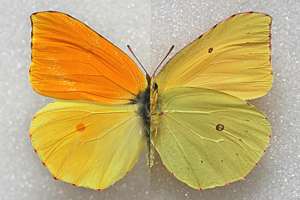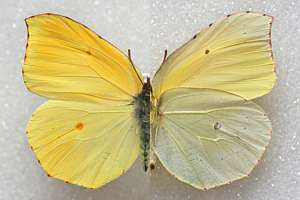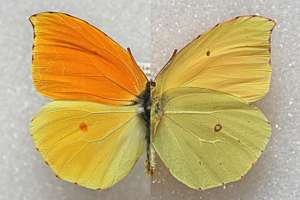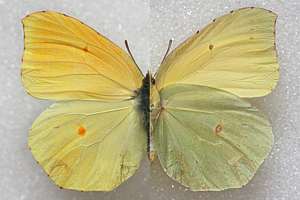 Gonepteryx cleobule (HĂśBNER, 1825)Teneriffa-Zitronenfalter, Canary BrimstonePapilionoidea
Gonepteryx cleobule (HĂśBNER, 1825)Teneriffa-Zitronenfalter, Canary BrimstonePapilionoidea
 Endemisch auf der Nordseite der Kanarischen Insel Teneriffa. (Endemit)
Endemisch auf der Nordseite der Kanarischen Insel Teneriffa. (Endemit)Lebenszyklus: Die Generationsfolge (einbrütig / mehrbrütig) ist ungeklärt
Habitat: Gonepteryx cleobule sowie deren Schwesternarten eversi und palmae kommen nur auf der Nordseite ihrer jeweiligen Insel vor. Die Art fliegt in den Lorbeerwäldern, im Sommer in Höhenlagen um 1000 bis 1500m (und höher), im Winterhalbjahr eher in tieferen Lagen
Biologie: Raupenfutterpflanzen: Rhamnus glandulosa und Rhamnus grenulata
 G. eversi ♂
G. eversi ♂  G. palmae ♂
G. palmae ♂ 
 G. eversi ♀
G. eversi ♀ G. palmae ♀
G. palmae ♀

 Kanarische Inseln, Teneriffe, Las Mercedes 800-900m, 12.-18.August 1987, leg. ROSE. Männchen.
Kanarische Inseln, Teneriffe, Las Mercedes 800-900m, 12.-18.August 1987, leg. ROSE. Männchen. Kanarische Inseln, Teneriffe, Las Mercedes 800-900m, 12.-18.August 1987, leg. ROSE. Weibchen.
Kanarische Inseln, Teneriffe, Las Mercedes 800-900m, 12.-18.August 1987, leg. ROSE. Weibchen. Kanarische Inseln, Teneriffe, Las Mercedes 800-900m, 12.-18.August 1987, leg. ROSE. Männchen.
Kanarische Inseln, Teneriffe, Las Mercedes 800-900m, 12.-18.August 1987, leg. ROSE. Männchen. Kanarische Inseln, Teneriffe, Las Mercedes 600-800m, 2.April 1987, leg. BATTENFELD. Weibchen.
Kanarische Inseln, Teneriffe, Las Mercedes 600-800m, 2.April 1987, leg. BATTENFELD. Weibchen.